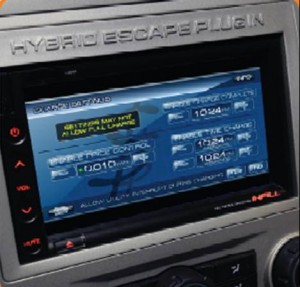
By John Addison (updated 10/15/09; original 8/24/09).
Ford is now taking orders for electric cars. By 2011, the Ford Motor Company will start taking orders for the new Ford Focus EV. Beyond 2011, Ford will offer the popular Focus in a variety of affordable options including hybrid-electric (HEV), plug-in hybrid (PHEV), and battery electric-vehicle (EV).
Although Nissan will take an early lead with EVs, and GM will beat Ford to market with a plug-in hybrid Chevy Volt, Ford will be fighting for market leadership with both electric vehicles and plug-in hybrids.
The Ford EV roadmap in this article is based on my interviews with Susan Cischke, Ford Group Vice President, Mike Tinskey, Plug-in 2009 Conference presentations, and my discussions with some of Ford’s utility partners.
2010 orders are likely to come from municipalities and other government agencies that will use the new Transit Connect light-duty van in a variety of applications from city maintenance to on-demand transit. Deliveries of these electric vehicles, made for Ford by Smith Electric Vehicles, will start in 2010. Transit Connect may also do well with small businesses and local delivery fleets.
It is the Ford Focus EV that captures the imagination of mainstream Americans eager to secure a zero-emission vehicle that they can take on freeways and travel up to 100 miles between charges. The new Ford Focus EV will be a 4-door sedan that seats five.
The Focus EV will be made in America. The sedan will travel 75 miles per charge with a 23kWh lithium-ion tri-metal battery. Ford has expressed a preference for a battery whose cells that are made in America. Ford’s final battery decision may be influenced by federal funding.
Ford is investing $550 million to transform its Michigan Assembly Plant into a lean, green and flexible manufacturing complex that will build Ford’s next-generation Focus global small car along with a new battery-electric version of the Focus for the North American market. Both will be based on a new global C platform. The EV is being developed in partnership with Magna International.
“The transformation of Michigan Assembly Plant embodies the larger transformation under way at Ford,†said Ford President and CEO Alan Mulally. “This is about investing in modern, efficient and flexible American manufacturing. It is about fuel economy and the electrification of vehicles. It is about leveraging our expertise and vehicle platforms around the world…â€
Ford will offer a plug-in hybrid in 2012. It has not yet announced the model. Ford’s first plug-in hybrid may be the Focus PHEV or the Escape Hybrid or both. A Ford Fusion PHEV could also be announced in 2012. Johnson Controls – SAFT is Ford’s lithium battery supplier for the first commercial plug-in hybrid (PHEV). Ford PHEV Press Releases
A Ford Focus PHEV is planned. It will be a blended hybrid using only an 8 to 13kWh lithium battery pack in contrast with the Chevy Volt series hybrid which will use 16kWh battery pack. All new Ford hybrid and plug-in hybrids will be blended parallel.
Ford can profit from the economies of scale by having common platforms for global vehicles and offering customers options which including engine powered, hybrid-electric, plug-in hybrid, and electric-vehicle. In a succession of announcements, Ford will make the Focus available in all of these configurations. By 2013, more than 90% of Ford’s new North American lineup will be available with EcoBoost technology.
Ford has been actively testing the plug-in hybrid Ford Escape with a number of utilities and partners. These tests have helped establish the standards necessary for electric vehicle success, such as the J1772 electrical connection that will be standard on Ford EVs.
Thanks to a new DOE award of $30 million, 50/50 matched, a total of $60 million will go into expanded deployment of Ford plug-in hybrids, electric vehicles, and infrastructure. Early pilots of the Ford Focus EV are likely to be part of this.
Ford did not receive its dream funding which would have been $250 million so that it could put 700 plug-ins (both EV and PHEV) into utilities and fleet tests. Ford wanted to pilot a mix of 700 vehicles including the Focus EV, a PHEV, Transit Connect, and E450 (Azure).
The new electric vehicles are smart EVs. Customers will be provided with charging options to save money. Drivers will be connected with traffic and location services and assisted with electronics that make driving safer. Passengers will have more information and entertainment options than ever. Like the new smartphones from Apple, Blackberry, Palm and others, the value of a full value of a smart car is in the networks. Just as smartphones can be purchased at a discount with network subscriptions, we may see similar offerings from car makers and their partners.
Subscription models are being explored where vehicles like the Ford Focus EV could be purchased, with the lithium battery and charging being offered as a subscription. Ford, Nissan, and other automakers are discussing such possibilities with electric utilities, financial institutions and others. Should a utility or JV own the batteries, then it would be easier to repurpose lithium batteries into less demanding stationary power back-up applications after the batteries decline in charge after several years of use.
Possibilities include 50/50 joint ventures and long-term secure financing. Because utilities are regulated, public utility commissions will be involved in approving new business models. If everyone gets there act together, which is certainly an “if,†the customer could be a big winner with an affordable EV and subscription offerings that cost less than monthly gasoline costs.
Under the leadership of CEO Alan Mulally, Ford has shown a new flexibility in partnering with suppliers, vehicle integrators, battery JV, electric utilities, financial institutions, and even information technology firms like Microsoft. With global platforms, richer partnerships, greater speed to market, hybrid cars, and electric cars, customers will see some interesting new offerings in the next two years.
